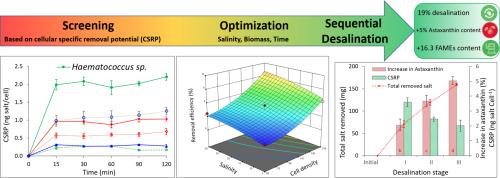Spontaneous sequential desalination as a promising strategy for biological salt removal and production of value-added compounds from microalgae
IF 6.7
2区 工程技术
Q1 ENGINEERING, CHEMICAL
引用次数: 0
Abstract
In this study, the potential of microalgae for spontaneous desalination was evaluated by assessing growth patterns and cellular specific removal potential (CSRP). Haematococcus sp. showed the highest CSRP (1.99 ng salt cell−1 in 15 min) and was selected for further optimization. Response surface methodology identified optimal conditions; initial salinity 28 ppt, culture volume 167.4 mL (1.37 g-biomass L−1 saline), and desalination time 46 min. Under these conditions, CSRP increased to 3.59 ng salt cell−1. Sequential desalination through three stages showed overall desalination efficiency of 18.9 %. Interestingly, astaxanthin content of Haematococcus sp. increased by 5.1 % after the third desalination stage. Fourier transform infrared spectroscopy of algal biomass before and after desalination confirmed the active participation of surface functional groups in ion binding. Furthermore, the effect of sequential desalination on fatty acid profiles revealed an increase in the content of fatty acid methyl esters (FAMEs) up to 16.3 % across the three desalination stages, confirming the potential for bioenergy applications. Biodiesel characteristics after sequential desalination showed a stability between the three stages, and all parameters were within those recommended by international standard. This study highlights the potential of Haematococcus sp. for bioactive compounds and biodiesel production, coupled with desalination, thereby helping to address the water-energy nexus.

自发顺序脱盐是一种很有前途的微藻生物脱盐和生产增值化合物的策略
在这项研究中,通过评估微藻的生长模式和细胞特异性去除电位(CSRP)来评估微藻的自发海水淡化潜力。其中,红球菌(Haematococcus sp.)的CSRP最高,为1.99 ng salt cell−1 in 15 min。响应面法确定最佳工艺条件;初始盐度28 ppt,培养体积167.4 mL (1.37 g生物量L−1盐水),脱盐时间46 min。在这些条件下,CSRP增加到3.59 ng盐细胞−1。通过三个阶段的顺序脱盐,总体脱盐效率为18.9%。有趣的是,经过第三阶段脱盐后,红球菌虾青素含量增加了5.1%。海水淡化前后藻类生物量的傅里叶变换红外光谱证实了表面官能团积极参与离子结合。此外,连续脱盐对脂肪酸谱的影响显示,脂肪酸甲酯(FAMEs)的含量在三个脱盐阶段增加了16.3%,证实了生物能源应用的潜力。顺序脱盐后生物柴油的特性在三个阶段之间表现出稳定性,各项参数均在国际标准推荐范围内。这项研究强调了红球菌在生物活性化合物和生物柴油生产方面的潜力,加上海水淡化,从而有助于解决水能关系。
本文章由计算机程序翻译,如有差异,请以英文原文为准。
求助全文
约1分钟内获得全文
求助全文
来源期刊

Journal of water process engineering
Biochemistry, Genetics and Molecular Biology-Biotechnology
CiteScore
10.70
自引率
8.60%
发文量
846
审稿时长
24 days
期刊介绍:
The Journal of Water Process Engineering aims to publish refereed, high-quality research papers with significant novelty and impact in all areas of the engineering of water and wastewater processing . Papers on advanced and novel treatment processes and technologies are particularly welcome. The Journal considers papers in areas such as nanotechnology and biotechnology applications in water, novel oxidation and separation processes, membrane processes (except those for desalination) , catalytic processes for the removal of water contaminants, sustainable processes, water reuse and recycling, water use and wastewater minimization, integrated/hybrid technology, process modeling of water treatment and novel treatment processes. Submissions on the subject of adsorbents, including standard measurements of adsorption kinetics and equilibrium will only be considered if there is a genuine case for novelty and contribution, for example highly novel, sustainable adsorbents and their use: papers on activated carbon-type materials derived from natural matter, or surfactant-modified clays and related minerals, would not fulfil this criterion. The Journal particularly welcomes contributions involving environmentally, economically and socially sustainable technology for water treatment, including those which are energy-efficient, with minimal or no chemical consumption, and capable of water recycling and reuse that minimizes the direct disposal of wastewater to the aquatic environment. Papers that describe novel ideas for solving issues related to water quality and availability are also welcome, as are those that show the transfer of techniques from other disciplines. The Journal will consider papers dealing with processes for various water matrices including drinking water (except desalination), domestic, urban and industrial wastewaters, in addition to their residues. It is expected that the journal will be of particular relevance to chemical and process engineers working in the field. The Journal welcomes Full Text papers, Short Communications, State-of-the-Art Reviews and Letters to Editors and Case Studies
 求助内容:
求助内容: 应助结果提醒方式:
应助结果提醒方式:


